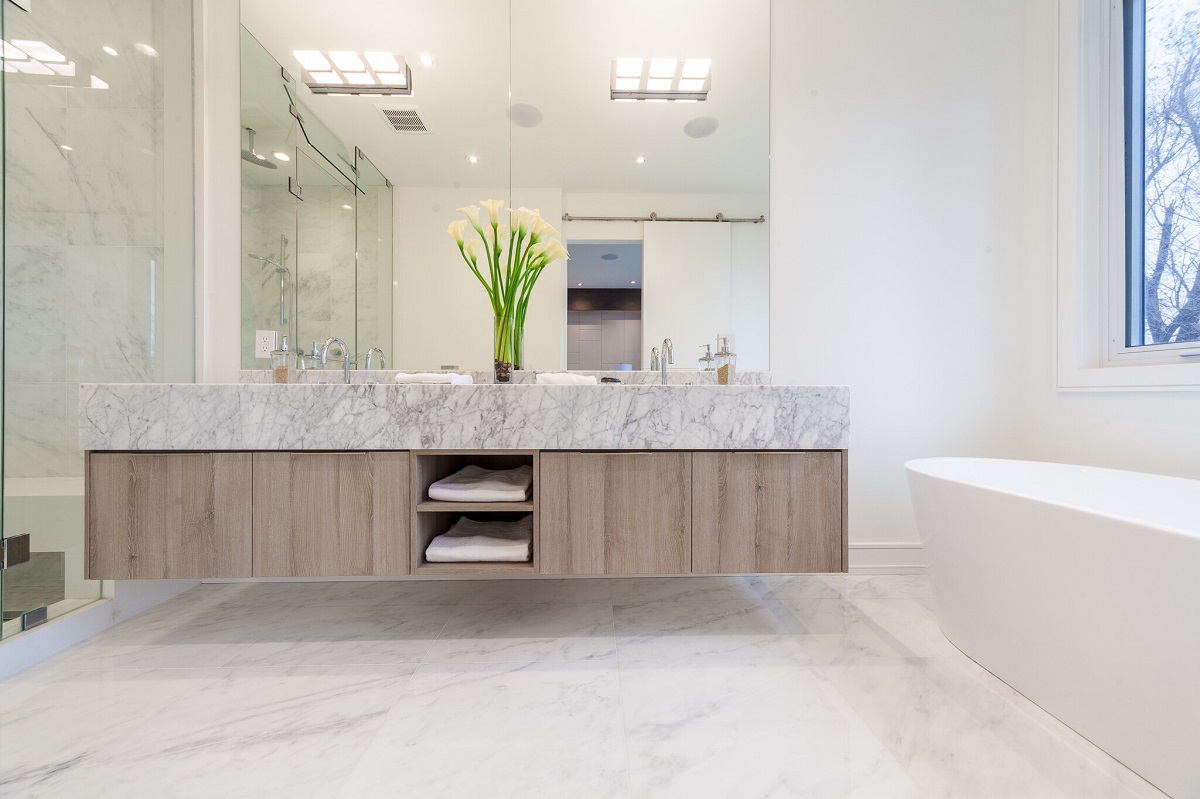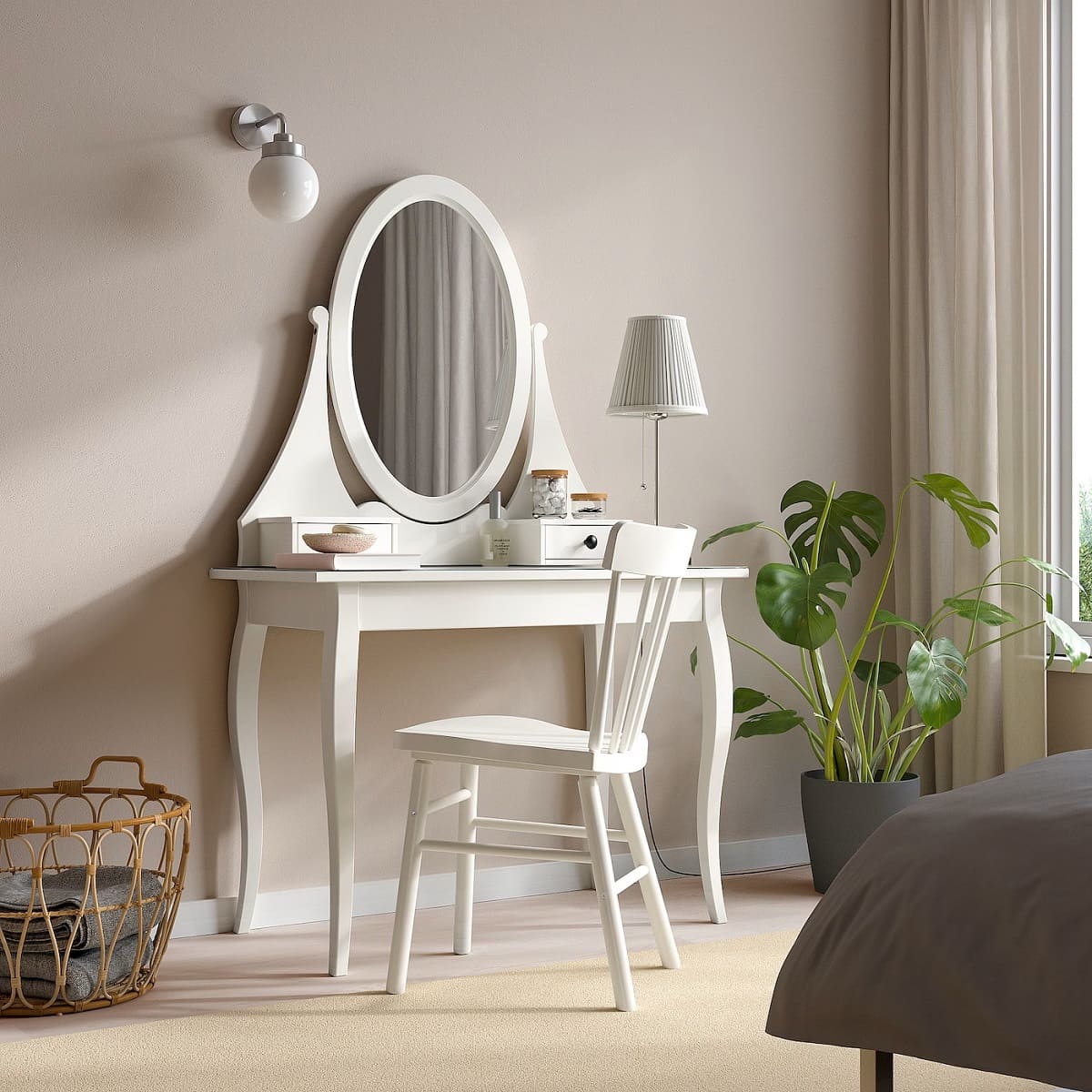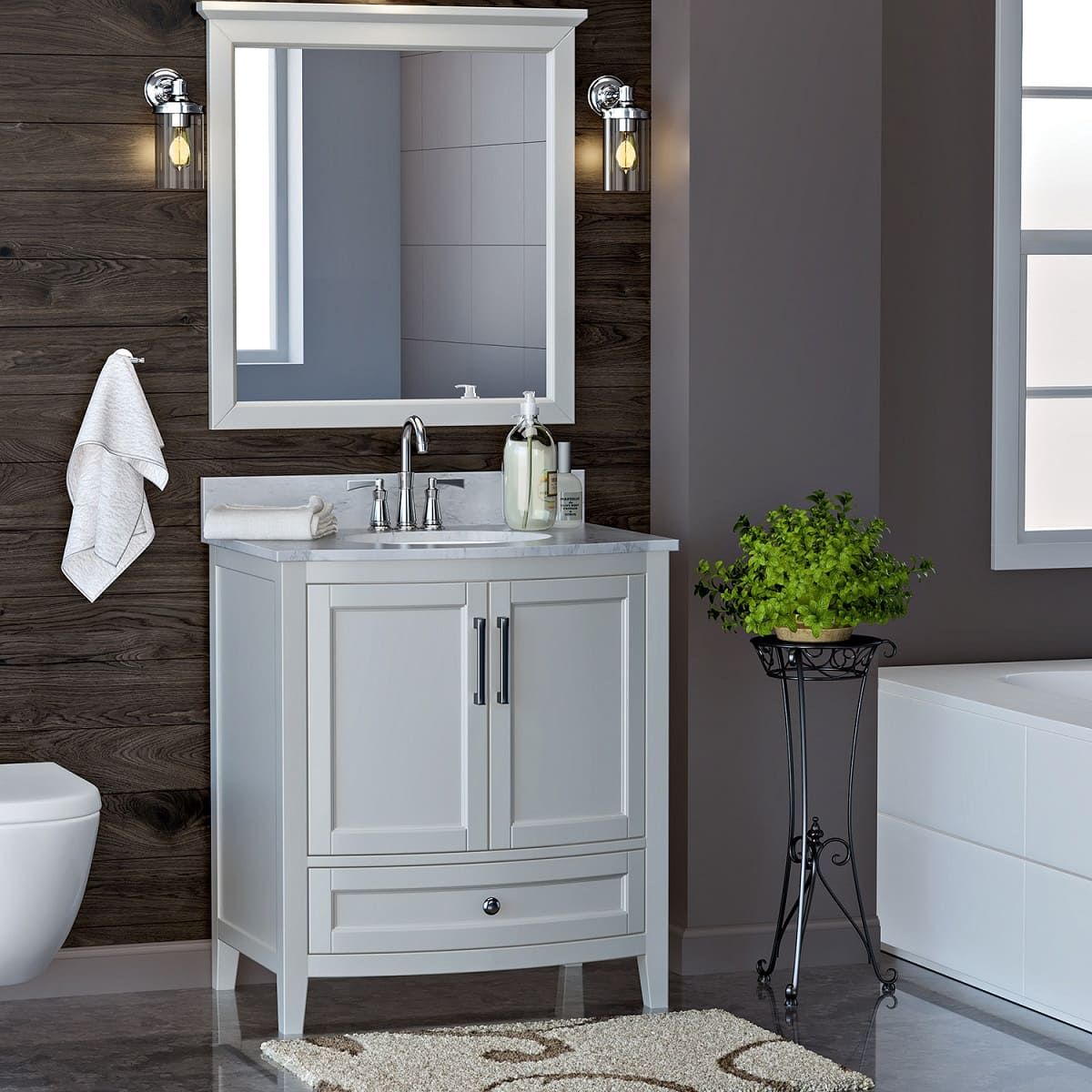Home>Articles>What Is The Standard Width Of A Bathroom Vanity


Articles
What Is The Standard Width Of A Bathroom Vanity
Modified: August 28, 2024
Discover the ideal standard width of a bathroom vanity in this informative article. Learn what size is best for your space and maximize functionality and style.
(Many of the links in this article redirect to a specific reviewed product. Your purchase of these products through affiliate links helps to generate commission for Storables.com, at no extra cost. Learn more)
Introduction
A bathroom vanity is an essential fixture in any bathroom. It not only provides storage space for your toiletries and other bathroom essentials but also contributes to the overall aesthetics of the room. Choosing the right bathroom vanity involves considering several factors, including the standard width.
In this article, we will explore the importance of understanding the standard width of a bathroom vanity. We will discuss the different types of bathroom vanities available and the factors to consider when making a choice. Additionally, we will delve into the standard width options, variations based on single or double vanities, and how bathroom layout and sink size impact vanity width.
By the end of this article, you will have a clear understanding of why the standard width of a bathroom vanity is crucial and how it affects the overall functionality and design of your bathroom.
Key Takeaways:
- The standard width of a bathroom vanity is crucial for both functionality and aesthetics, ranging from 24 to 72 inches. Consider layout, sink size, and personal preferences to make an informed decision.
- Matching the width of your bathroom vanity with the appropriate sink size ensures optimal functionality and creates a visually pleasing and balanced bathroom design. Consider single or double sink options based on your needs and available space.
Understanding Bathroom Vanities
Bathroom vanities serve both practical and aesthetic purposes in a bathroom. They are designed to provide storage space for toiletries, towels, and other essentials, keeping your bathroom organized and clutter-free. Additionally, bathroom vanities can enhance the overall visual appeal of the room, serving as a focal point or complementing the existing décor.
When it comes to types, there are various options available to suit different styles and preferences. Some common types of bathroom vanities include:
- Freestanding Vanities: These are standalone vanities that are not attached to the wall. They come in a variety of styles, materials, and sizes, offering flexibility in design and placement.
- Wall-Mounted Vanities: These vanities are attached directly to the wall, creating a sleek and modern look. They are ideal for smaller bathrooms, as they create the illusion of more floor space.
- Corner Vanities: As the name suggests, corner vanities are designed to fit into the corners of a bathroom. They maximize space utilization and work well in smaller or irregularly shaped bathrooms.
- Vessel Sink Vanities: These vanities feature a vessel sink, which sits on top of the vanity countertop. They can add a touch of elegance and sophistication to your bathroom, making a statement.
- Double Vanities: Double vanities are wider and offer two sinks, making them a practical choice for shared bathrooms or bathrooms used by couples. They provide ample countertop space and storage for each person.
Each type of bathroom vanity has its advantages and considerations, and choosing the right one depends on your specific requirements and preferences. It is essential to consider the purpose and importance of the vanity in your bathroom and how it fits into the overall design scheme.
Factors to Consider When Choosing a Bathroom Vanity
Choosing the right bathroom vanity involves considering a few important factors. These factors will not only impact the functionality of your vanity but also contribute to the overall design and aesthetics of your bathroom. Here are some key factors to keep in mind:
- Standard Width as a Crucial Consideration: The width of a bathroom vanity is perhaps the most critical dimension to consider. It determines how much countertop space and storage you will have. It is essential to choose a vanity with a width that fits your needs and the available space in your bathroom.
- Other Dimensions to Keep in Mind: While width is important, it is equally important to consider the depth and height of the vanity. The depth will determine how far the vanity protrudes into the bathroom space, and the height will impact the comfort and accessibility of the countertop and sink.
- Style and Design Choices: Bathroom vanities come in a wide range of styles, materials, and finishes. Consider the overall style of your bathroom and choose a vanity that complements or enhances the existing design. Whether you prefer a traditional, rustic, modern, or minimalist style, there is a vanity available to suit your taste.
By carefully considering these factors, you can select a bathroom vanity that not only fits your functional needs but also adds to the visual appeal and ambiance of your bathroom. The right choice can transform your bathroom into a more organized, efficient, and aesthetically pleasing space.
Standard Width of Bathroom Vanities
The width of a bathroom vanity is a crucial aspect to consider when choosing one for your bathroom. It determines the amount of countertop space available and the overall size of the vanity. Finding the right width is essential for both functionality and aesthetics.
The importance of finding the right width:
Choosing a vanity that is too narrow can result in limited countertop space, making it challenging to store and use your daily essentials. On the other hand, a vanity that is too wide can overwhelm the bathroom space and hinder movement. It is essential to strike a balance and find the right width that meets your storage needs without overpowering the room.
Common standard width options:
Standard bathroom vanities typically range in width from 24 inches to 72 inches. Here are some common width options:
- 24-30 inches: These narrower width options are suitable for smaller bathrooms or powder rooms. They provide enough storage and countertop space for essential items without dominating the room.
- 36-48 inches: These mid-range width options are versatile and can work well in average-sized bathrooms. They offer a good balance between storage space and countertop area.
- 60-72 inches: These wider width options are typically chosen for larger bathrooms or master suites. They provide ample storage and countertop space and can accommodate double sinks.
Variations based on single or double vanities:
The width of a bathroom vanity can vary based on whether it is designed for a single sink or double sinks. Single vanities are typically narrower, ranging from 24 to 48 inches, while double vanities are wider, starting from 60 inches and going up to 72 inches or more. Double vanities are an excellent choice for shared bathrooms or bathrooms used by couples, as they provide individual space and storage for each person.
When considering the width of your bathroom vanity, take into account the size of your bathroom, the available space, and your storage needs. It’s also essential to consider any plumbing fixtures that may impact the placement and size of the vanity. By carefully considering these factors, you can choose a vanity with the right width to enhance the functionality and aesthetics of your bathroom.
The standard width of a bathroom vanity is typically between 24 to 72 inches. When choosing a vanity, consider the size of your bathroom and the available space for installation.
Impact of Bathroom Layout on Vanity Width
When choosing a bathroom vanity, it’s important to consider the layout of your bathroom. The available space and the placement of plumbing fixtures can have a significant impact on the width of your vanity. Understanding how the bathroom layout influences the vanity width will help you make the right choice for your unique space.
Considering available space:
The size and shape of your bathroom will determine the maximum width of the vanity that can comfortably fit in the space. If you have a smaller bathroom, you may need to opt for a narrower vanity to ensure there is enough room to move around. On the other hand, if you have a spacious bathroom, you have the flexibility to choose a wider vanity that provides ample countertop space and storage.
Accommodating plumbing fixtures:
Plumbing fixtures, such as the sink, faucets, and drain pipes, need to be taken into consideration when determining the width of your vanity. It’s crucial to ensure that there is enough space for the plumbing to be properly connected without interfering with the functionality of the vanity. You may need to choose a vanity that provides adequate clearance for the plumbing fixtures and allows for easy installation and maintenance.
Customizing width for unique layouts:
In some cases, you may have a bathroom with a non-standard or unconventional layout. This could include angled walls, alcoves, or irregularly shaped spaces. In such situations, you may need to customize the width of the vanity to fit the unique layout of your bathroom. Custom-made vanities can be designed to match the specific dimensions and angles of your space, ensuring a seamless fit and maximizing the functionality of your bathroom.
By considering the available space, accommodating plumbing fixtures, and customizing the width if necessary, you can ensure that the vanity you choose fits perfectly into your bathroom layout. This will prevent any issues with functionality, ensure efficient use of space, and create a visually appealing and balanced bathroom design.
Read more: What Is The Standard Bathroom Vanity Height
Matching Vanity Width with Sink Size
When selecting a bathroom vanity, it’s important to consider the size of the sink and ensure it matches the width of the vanity. Properly matching the vanity width with the sink size is crucial for ensuring optimal functionality and creating a visually balanced bathroom design.
Ensuring proper functionality:
The width of the vanity should be able to accommodate the size of the sink. If the vanity is too narrow for the sink, it can restrict the space available for washing hands or performing other daily tasks. On the other hand, if the vanity is too wide for the sink, it may result in wasted countertop space and an unbalanced appearance. Matching the width of the vanity with the appropriate sink size ensures that the sink and countertop are proportionate and provide a comfortable and functional experience.
Single vs. multiple sinks and their impact on width:
One of the considerations when matching vanity width with sink size is whether you require a single sink or multiple sinks. Single sinks are more commonly found in smaller bathrooms or powder rooms where space is limited. They typically require a narrower vanity, ranging from 24 to 48 inches in width.
On the other hand, if you have a larger bathroom or a shared bathroom used by multiple individuals, you may opt for a vanity with multiple sinks. Double sink vanities are popular choices for these scenarios, as they offer separate spaces for each individual. Double sink vanities are wider, starting from 60 inches and can go up to 72 inches or more. The width of the vanity will depend on the size and style of the sinks as well as the desired configuration.
When choosing a vanity with multiple sinks, it’s important to ensure that the width provides enough space for each sink and allows for comfortable usage. Additionally, considering the placement of faucets and other accessories in relation to the sink size is essential to ensure a harmonious and functional design.
By matching the width of the vanity with the appropriate sink size, you can ensure proper functionality, optimize the use of countertop space, and create a visually pleasing bathroom design that meets your needs and preferences.
Conclusion
Choosing the right width for a bathroom vanity plays a significant role in both the functionality and aesthetics of your bathroom. Understanding the standard width options and considering the layout, available space, plumbing fixtures, sink sizes, and your own personal preferences are crucial in making an informed decision.
By finding the right width for your bathroom vanity, you can ensure sufficient countertop space for your daily routines and proper storage for your bathroom essentials. A well-fitted vanity enhances the functionality of your bathroom and contributes to a clutter-free and organized space.
The standard width options for bathroom vanities range from 24 to 72 inches, with variations for single and double vanities. It’s important to consider the size and layout of your bathroom, as well as any unique features or constraints, to determine the optimal width for your vanity. Customization may be necessary for irregular layouts or specific requirements.
Additionally, matching the width of your vanity with the size of the sink is essential for proper functionality and aesthetic appeal. Whether you choose a single sink or multiple sinks, ensuring that the sink size is proportionate to the vanity width creates a harmonious and balanced look in your bathroom.
In conclusion, the standard width of a bathroom vanity is a key consideration in creating a functional and visually appealing bathroom. By taking into account the various factors involved, you can make an informed decision that meets your needs and enhances the overall design of your bathroom.
Frequently Asked Questions about What Is The Standard Width Of A Bathroom Vanity
Was this page helpful?
At Storables.com, we guarantee accurate and reliable information. Our content, validated by Expert Board Contributors, is crafted following stringent Editorial Policies. We're committed to providing you with well-researched, expert-backed insights for all your informational needs.















0 thoughts on “What Is The Standard Width Of A Bathroom Vanity”